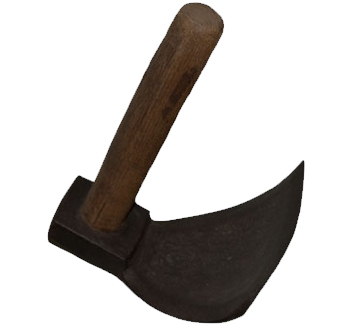
An adze
Discover how clogs are made. Click on the names of the tools that appear in purple to get a picture.
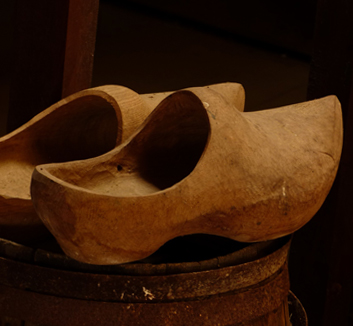 In the middle of the 19th century, the clog maker had a large number of customers; all the villagers, men and women, wore wooden clogs. In fact, despite the use of leather, shoes made of this material were still rare and expensive; shoes were reserved for special occasions or for dignitaries. The clogmaker was therefore essential and present in every village. He could make up to 3 pairs of clogs a day, which meant about 15 hours of work. It should be noted that at the time, a farmer would renew his clogs 3 to 4 times a year. Some people bought them in a larger size in order to add straw, hay or slippers in them.
In the middle of the 19th century, the clog maker had a large number of customers; all the villagers, men and women, wore wooden clogs. In fact, despite the use of leather, shoes made of this material were still rare and expensive; shoes were reserved for special occasions or for dignitaries. The clogmaker was therefore essential and present in every village. He could make up to 3 pairs of clogs a day, which meant about 15 hours of work. It should be noted that at the time, a farmer would renew his clogs 3 to 4 times a year. Some people bought them in a larger size in order to add straw, hay or slippers in them.
The clog maker generally exploits the walnut tree which he buys on the ground. This expensive tree must be at least 2 m in circumference and its core or blackwood must occupy most of the trunk.
The tree is then uprooted; the base is cleared with a pickaxe and the roots are chopped off with an axe. The marlwood, or building timber, is collected, while the stump is sold for industrial purposes. The logs are then transported to the shop by horse and cart.
After being transported, the logs are cut into 1 meter long pieces and then sliced into 3 pieces ranging from 35 to 40 cm. This allows to produce sizes up to a size 46.
These pieces are then divided into several quarters according to the thickness of the trunk.
How to find the size of a pair of clogs?
Simply measure the inside of the hoof and add its half.
Example:
Inside measurement = 30 cm + 15 cm = size 45.
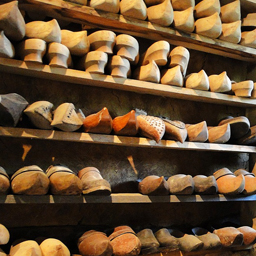 The drying is a fundamental step in the manufacturing process. Wood can only be worked with when it is half dry. It takes place before and after the roughing. It can last several weeks if the clogs are hung in the shop or overnight if they are put in a drying room.
The drying is a fundamental step in the manufacturing process. Wood can only be worked with when it is half dry. It takes place before and after the roughing. It can last several weeks if the clogs are hung in the shop or overnight if they are put in a drying room.
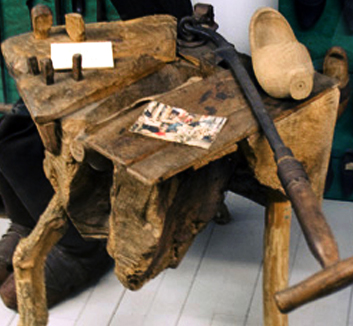 About fifteen tools are needed to shape the future clog! First of all, the quarter of wood is placed on a block ( picture opposite). The roughing of the clog then begins with a board axe. The adze is used to roughly shape the heel. The piece is then shaped with the parer, a long 60 cm blade attached to the ring of the block, giving leverage and allowing to work at different angles and thus shaping the outside of the clog. Wedges are then used to hold the blank in place while the digging is started with an auger, a spinner to hollow out the clog with the help of a spoon. A currying knife is used to shape the tip while the heel knife, as its name suggests, is used to shape the outside of the heel. A hook knife is used to hollow out the bottom and the tip, then a double-edged curved knife is used to smooth out and finish the inside.
About fifteen tools are needed to shape the future clog! First of all, the quarter of wood is placed on a block ( picture opposite). The roughing of the clog then begins with a board axe. The adze is used to roughly shape the heel. The piece is then shaped with the parer, a long 60 cm blade attached to the ring of the block, giving leverage and allowing to work at different angles and thus shaping the outside of the clog. Wedges are then used to hold the blank in place while the digging is started with an auger, a spinner to hollow out the clog with the help of a spoon. A currying knife is used to shape the tip while the heel knife, as its name suggests, is used to shape the outside of the heel. A hook knife is used to hollow out the bottom and the tip, then a double-edged curved knife is used to smooth out and finish the inside.
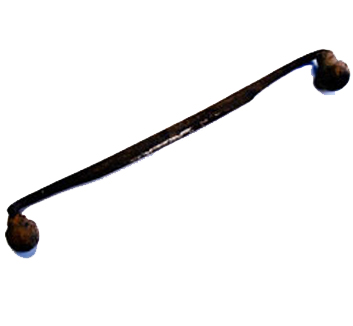 To smooth out the imperfections, the clogmaker uses a plane, a long blade with two handles, or a scraper. He then places a wire in a groove on each side of the clog to ensure the solidity of the shoe: the fret.
To smooth out the imperfections, the clogmaker uses a plane, a long blade with two handles, or a scraper. He then places a wire in a groove on each side of the clog to ensure the solidity of the shoe: the fret.
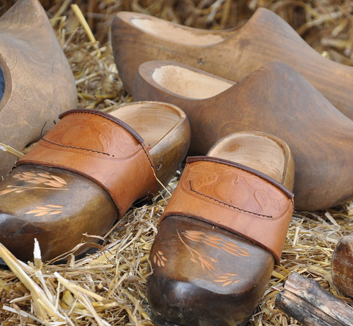 The pair of clogs could be bare, coated with a soot-based dye, smoked, waxed, but also decorated with geometrical or floral patterns drawn with a knife or provided with a leather strap with embossed patterns.
The pair of clogs could be bare, coated with a soot-based dye, smoked, waxed, but also decorated with geometrical or floral patterns drawn with a knife or provided with a leather strap with embossed patterns.